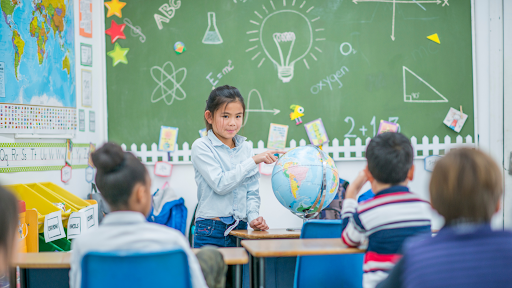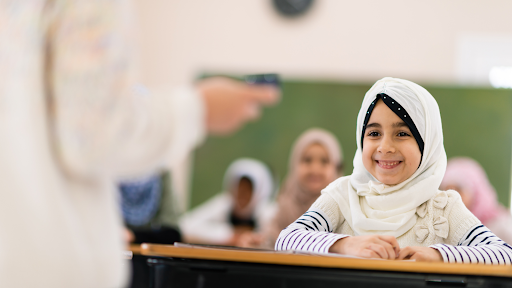Once upon a time in the not so distant past when I was completing my ESL add-on licensure, one of my assignments was to observe an ESL class. During the observation, the teacher told a long (and probably greatly embellished and exaggerated) story about her husband trying to catch a wasp that had entered her house. Her group of high school students were absolutely riveted as she told the story and acted out her husband’s actions. She deepened her voice as she played the part of her husband and provided dramatic buzzing for the wasp. EVERYONE was paying attention! Students were turning to their neighbor for translations when they didn’t understand. It was an Academy Award worthy performance and was also my introduction to using storytelling in an ESL classroom.
I didn’t know then the importance of “telling a story” for English learners. At the time I thought the ESL teacher was just using it as an icebreaker to engage students early on a Monday morning. Later I learned that storytelling enhances listening skills, increases focus and concentration, teaches vocabulary, and promotes empathy. When the “story” becomes a personal narrative, it takes on a life of its own as an effective tool that incorporates both literacy and cultural knowledge. Sharing personal experiences can be a powerful and authentic way to build a student’s skills.
Identity, Mapping, and Student Voice

Storytelling predates the written words. Think of the oral traditions handed down from one generation to another. What would a family get-together be without recounting old favorite family stories and hearing new ones? Edutopia has a fascinating read about Harnessing the Power of Storytelling. In this post, Abeer Shinnawi discusses the idea of “ecology of identity.” Basically, this means that who we are is “profoundly influenced by our physical and social environment.” The article goes into more detail about the “ecological layers” of identity and has a template for students to create their own “Identity Map.” Once Identify Maps are created, the article gives suggestions on how the students can apply what they discover about themselves in concrete ways.
You may be thinking that this all sounds good, but how do I get started? The Voice of Witness has a great (free!) resource guide for getting started. It is designed for English Language Learners, but all students could reap the benefits of creating their own oral histories. It contains discussion strategies, reading comprehension handouts, and interview actitivies. I especially like the requisite skills’ activities. The guide offers strategies to lay the foundational skills needed to take on the task of telling or writing a personal narrative. Some of the activities include: using cue cards to facilitate discussions, practicing reading aloud, and teaching students strategies for active listening.
Stories Need an Audience

As with many things, listening is a good place to begin. Depending on the levels of the students, direct listening instruction may be required. Start with listening for the main idea of a short text. Breaking News English has thousands of free English news lessons. This site provides multiple levels of the same story with audio recordings. The audio recordings lets you choose the speech rate, and some passages give the choice of British English or North American English.
After students begin to independently determine the main idea, the same stories can be used to move on to listening for details. This is a great time to use the wh-words: who, what, why, when, and where to draw out the details. The written text is also provided and could be used by the teacher to read aloud and for the students to follow along. The passages could also be used for expressive skills practice for the students to retell the story to the class.
Laughing While Learning

Speaking of speaking, you’ve got to get your students talking first! Start with some Fun Speaking Games to help students overcome their apprehension about speaking to the whole class. Try to pair the game with your students’ comfort levels. I especially like #3 and #4 for getting students started. In the Descriptive Drawing Activity (#3), you could change it up to have one student describe the picture and, rather than have the other one draw it, have the other student try to guess what it is to keep them talking to each other.
Prompts like the cue cards from the Voice of Witness resource could also be provided to scaffold the activity. I LOVE comic strip activities like the #4 Comic Strip Description. Comic strips are great to use with ELL students as they provide illustrations along with the text. iSLCollective has a great resource for comic inspired worksheets and activities.
Expanding the Narrative

When you’re ready to take the next step and have students create a personal narrative, 826 National has awesome resources to help you do just that. “826’s goal is to encourage the exploration of endless possibility through the power of writing.” It is the largest writing network in the US with chapters in several large cities. If you’re lucky enough to live near one, there are lots of programs you can take advantage of. But, if you don’t, their website offers many resources. Their free online platform offers inspiration for young writers. You just have to sign up for a digital account. But, by far the best thing about their website is that they feature student writings. There are some powerful messages in the students’ writing. You may find a student writing that will inspire even the most reluctant reader or writer.
Once the students are able to tell their stories, the storytelling doesn’t have to end! Expand the storytelling to historical narratives, myths, legends, and fairy tales. Scholastic has a list of their favorites. Students could practice and then read or record themselves reading the stories. They could role play the story and take turns acting it out. Students of all ages love picture books. My high school library has a “curated” collection of picture books. but you can create your own collection. I use Cyclops by Leonard Everett Fisher when I teach The Odyssey to present a different way of telling that part of the story. The True Story of the 3 Little Pigs! by Jon Scieszka is a great way to illustrate point of view after reading the original story.
One last thing about writing personal narratives. They don’t have to be stories written in the traditional way. Stories can be told in poetry or digitally. Here are some great resources:
- Writing Poetry with English Language Learners by Kristina Robertson
- https://www.commonsense.org/education/top-picks/apps-and-sites-for-storytelling
However you choose to do it, never underestimate the power that storytelling can have on your students’ learning and their sense of self within your classroom. My colleague Annie has a wonderful piece all about the power of bringing a student’s home-life and experiences into the classroom.



